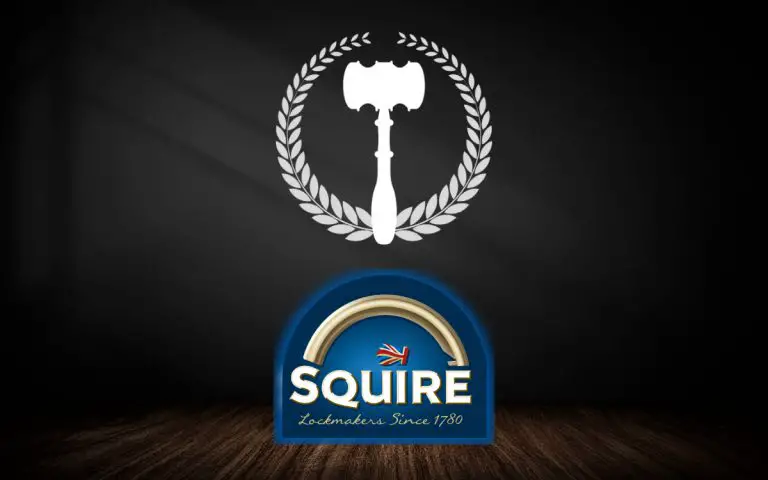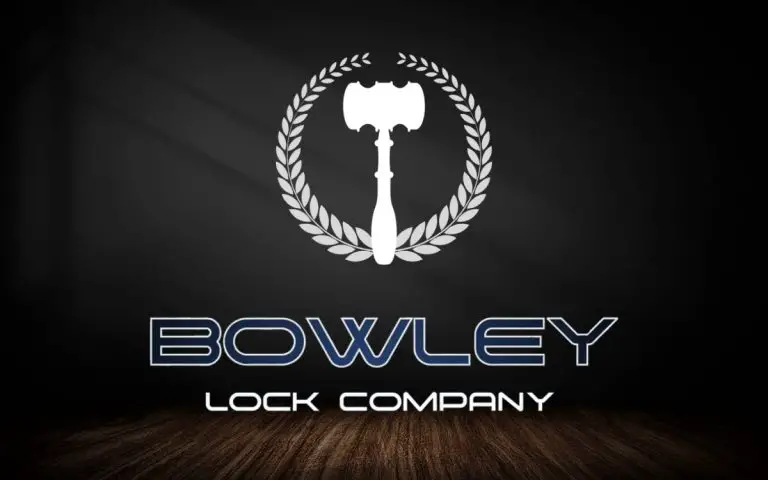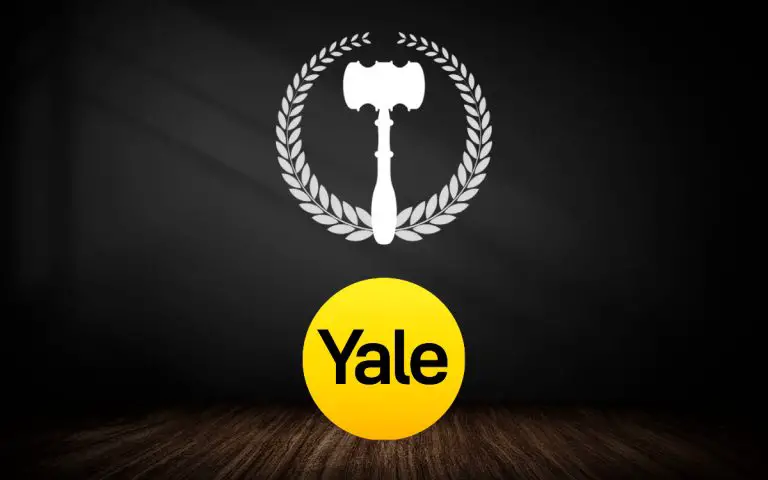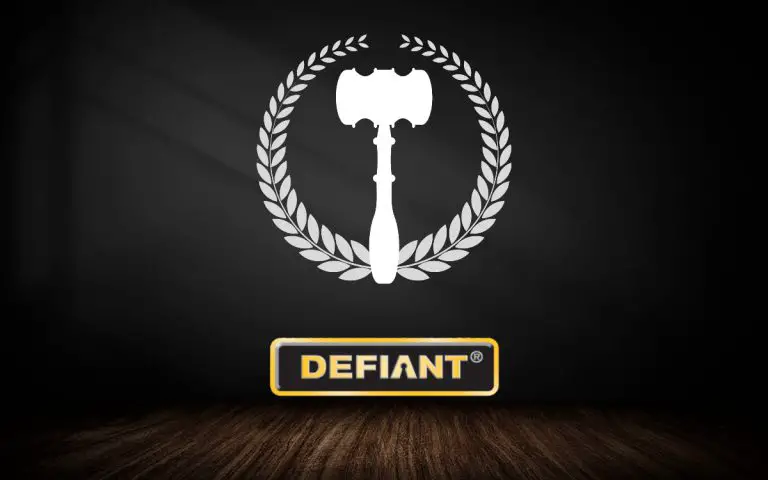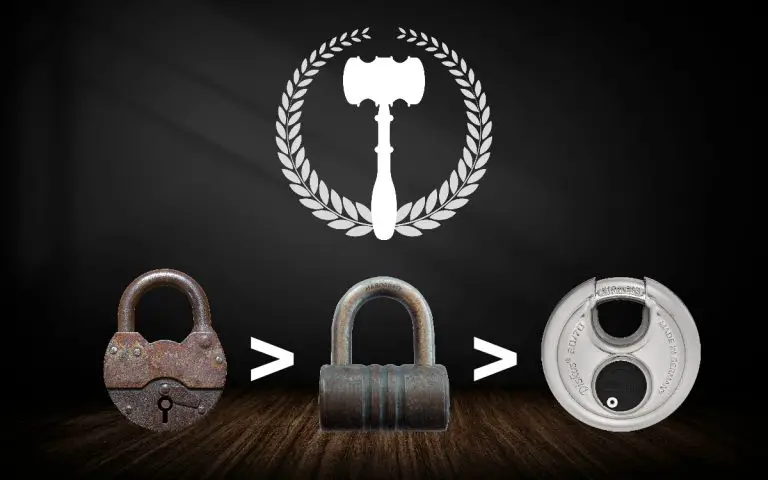Don’t Buy a Door Lock Until You Read This…
When you install or replace a door that you want to lock, what type of lock should you use?
The primary factors for locks are frequency of use, access requirements, and security. Interior doors usually require lower security than exterior doors, which is a major distinction in choosing a door lock type.
Two securing mechanisms may be needed for doors that are usually latched but not always locked. This is why there is usually a latch on exterior doors, which may or may not be locked, as well as a deadbolt or other locking mechanism for more security and robustness.
7 Types of Door Locks
There are 7 common types of door locks:
Door Knob
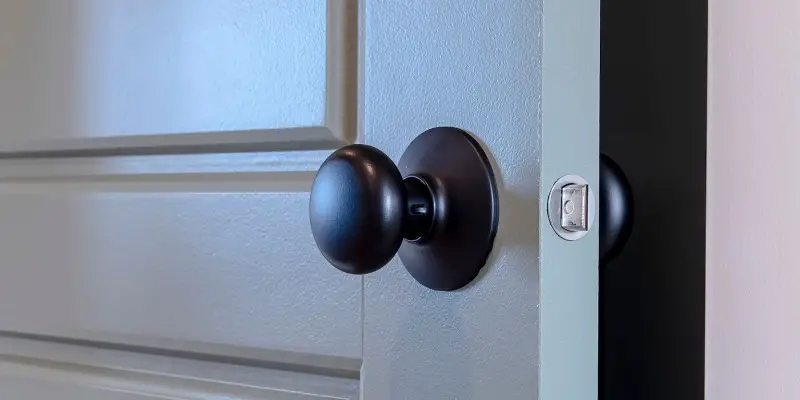
Most of us are familiar with a knob, or key-in-knob (KIK), locks in which a key is inserted into the lock cylinder contained in the center of the knob. Some knob door locks have a lever handle rather than a round handle.
Where to Use
- Interior doors with unkeyed locks such as bedrooms, bathrooms, and utility rooms where only temporary low security is required.
- Exterior doors for low security if keyed locks are used.
- Interior doors where keyed access is needed.
- Exterior locks in conjunction with deadbolts for more security.
Benefits
- Wide range of prices so inexpensive ones can be selected.
- Lever knobs allow easy operation for the physically impaired.
- Fairly easy to install.
- Simple operation.
- Can be keyed on both sides or thumb latch/push button operation on the inside.
Drawbacks
- Easily bypassed with a shim if improperly installed.
- The lock mechanism is exterior to the door, and therefore, more vulnerable to physical attack.
- Requires deadbolt lock for higher security.
If you are looking for a new door lock you can find our list of the best door locks here
Deadbolt
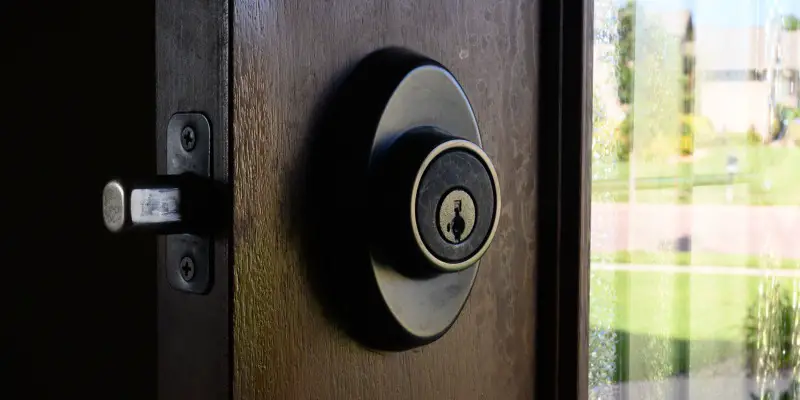
Deadbolt door locks have a horizontal unsprung (thus the word “dead”) bolt is operated by turning a key or a latch. These are often used in conjunction with door knob locks. They can be keyed on one or both sides.
Where to Use
- Exterior doors of houses, garages, and sheds either by themselves or in addition to a knob or knob lock.
- Where entry and exit require the use of a key.
- Interior doors where a knob is not required but keyed security is.
Benefits
- Cannot be shimmed open.
- Some resistance to physical attacks.
- Wide range of prices depending on robustness and lock core security.
- Can be keyed on just one side.
Drawbacks
- No knob, so it must be either locked or unlocked.
- Unlocking does not keep the door closed unless used in conjunction with a knob.
- In a single-keyed version, a thumb lock could be turned from outside if a physical bypass of the door is possible.
Mortise Lock
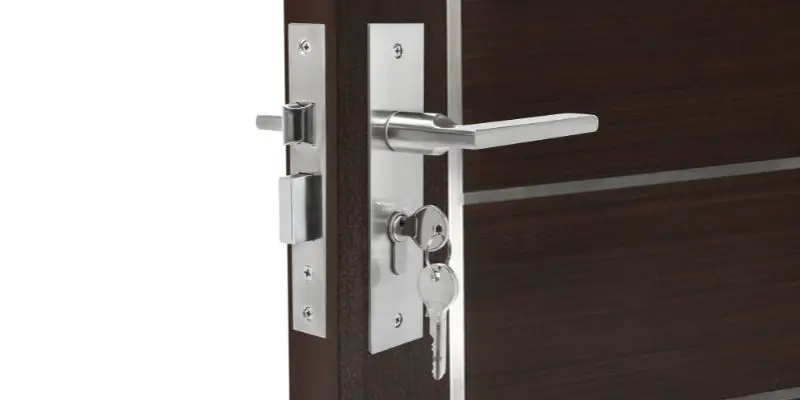
A mortise lock is often found in older buildings. These are locks that are “mortised” or cut into the edge of the door and have knobs or levers and keyways on both sides of the door to operate. They usually combine a beveled latch and a deadbolt in one mechanism.
Where to Use
- Unkeyed or simple thumb lock without a deadbolt for interior doors.
- Keyed version for exterior doors.
- Where creating a mortised cavity in the edge of a door is feasible.
Benefits
- Combines latch and deadbolt in one mechanism.
- The latch can be used without deadbolt operation.
- Can be keyed on one or both sides.
- Lock mechanism located inside the door for increased security.
- Can employ night latch operation for keyless egress.
Drawbacks
- Installation can be difficult without a mortising jig.
- The latch plate must be installed accurately into the door jamb.
Cam Lock
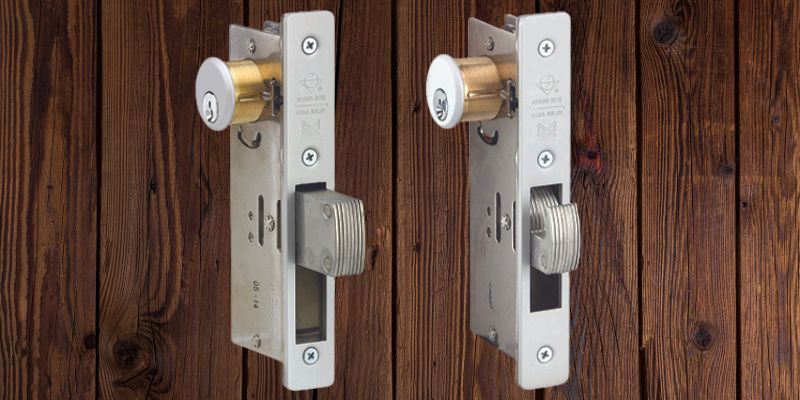
A cam lock has a rotating arm or cam that is attached or operated by the locking mechanism with a key or a wing knob. Small cam locks are used to secure drawers and cabinet doors, while large ones are more common in commercial storefront doors than residential ones.
Simple cam locks are frequently found in cabinets, drawers, lockers, and other low-security applications due to their simple lock cores and susceptibility to levered prising between door and jamb.
Commercial-grade cam locks are frequently seen in metal-framed glass doors in commercial buildings, which are mortised into the edge of the door. These can be high-security locks with either one or two keyed sides.
Where to Use
- Simple cam locks can be used in lockers, cabinets, drawers, and doors which require low security.
- High-grade ones are used in metal-framed glass doors due to their convenient form factor for the tall, narrow metal frame.
Benefits
- Low-grade cam locks are cheap, useful for low-security applications, easily installed, and useful to deter casual intruders such as children or curious interlopers.
- Commercial-grade cam locks are fairly high security and probably the best choice for metal-framed, glass doors.
Drawbacks
- Low-grade cam locks can be bypassed or picked with simple tools and are susceptible to physical attacks.
- Commercial-grade cam locks are expensive.
- Single-keyed ones can be opened by rotating the interior thumb turn if the door can be bypassed.
Keypad
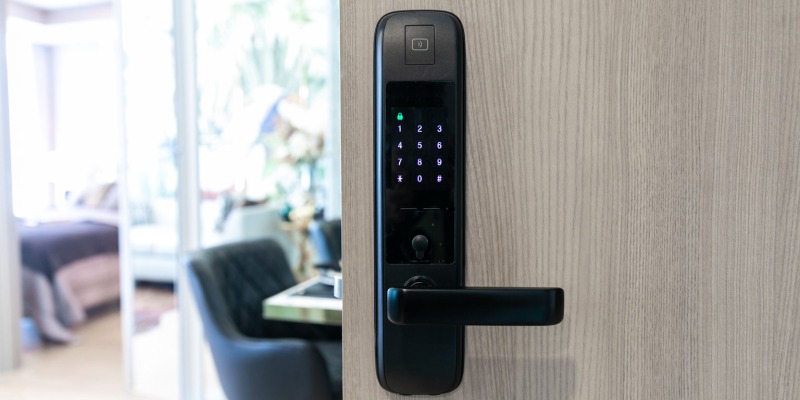
A keypad lock is a keyless electronically or mechanically controlled lock in which one punches a code on a keypad to operate the lock. It sometimes has a conventional keyed lock backup in case of keypad power source failure.
Where to Use
- Usually exterior doors but interior doors where key management can be a problem, e.g., many users or large families.
- When temporary access needs to be granted, keyed access is difficult.
Benefits
- Decreased key management.
- Physical key not required.
- Codes can be frequently changed as users change or to increase security.
Drawbacks
- Security can be compromised if codes are shared–codes should be frequently changed.
- Electronically controlled ones must have a power source–usually batteries.
- If batteries are depleted, keyed access is required; a lock mechanism is outside the door.
Smart Lock
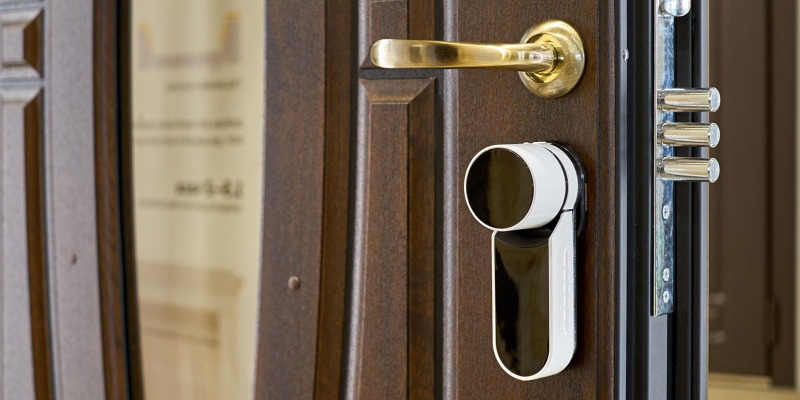
A smart lock is a locking mechanism that can be controlled remotely via Bluetooth or Wi-Fi. It may have a keypad, in which case it will have the appearance and functionality of a keypad lock as well as being connected to your smartphone, or it may lack a keypad and look nothing like a conventional door lock.
Where to Use
- Usually, exterior doors where remote access needs to be granted.
- Convenient keyless entry is desired.
- Phone-controlled devices are used.
- Physical key management is a problem for multiple users.
Benefits
- The lock can be operated remotely.
- Access can be granted quickly and for specific times/durations.
- The owner is notified of entry and exit.
- Combines surveillance and access.
- Batteries can be used, and users can be notified of their status.
Drawbacks
- Requires a power source and Wi-Fi or Bluetooth connection.
- Power source can fail.
- Sometimes has no physical key backup
- Batteries are used.
Like the idea of a smart lock? We have a list of smart locks here.
Padlock
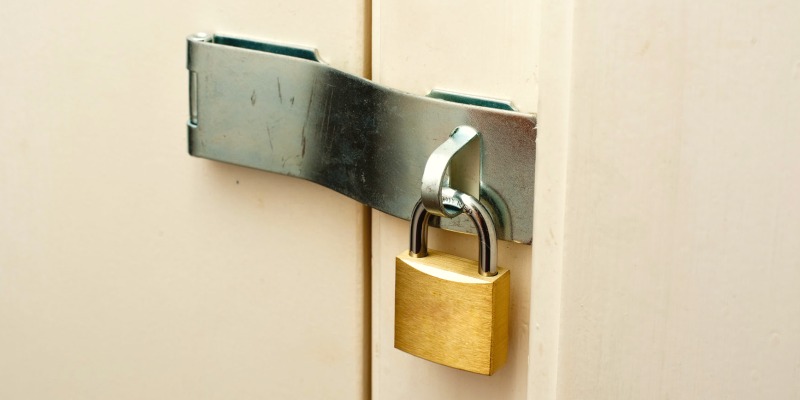
A padlock is a locking mechanism separate from the door and requires a shackle and has to be attached to the facility. It is usually operated by key or combination. For added security, some padlocks have shielded shackles to help protect against bolt cutters or other physical attacks.
Puck padlocks (resemble a hockey puck) are very secure from physical attacks as there is no exposed shackle, and the door shackle and hasp are partially concealed.
Another version of a partially shrouded padlock is the disc lock which is common on storage facility doors. They are less susceptible to physical attacks, such as the use of bolt cutters.
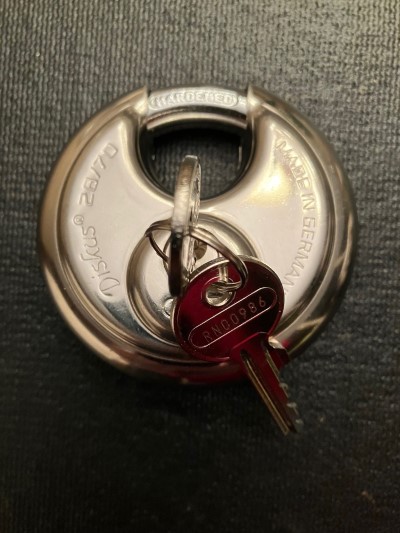
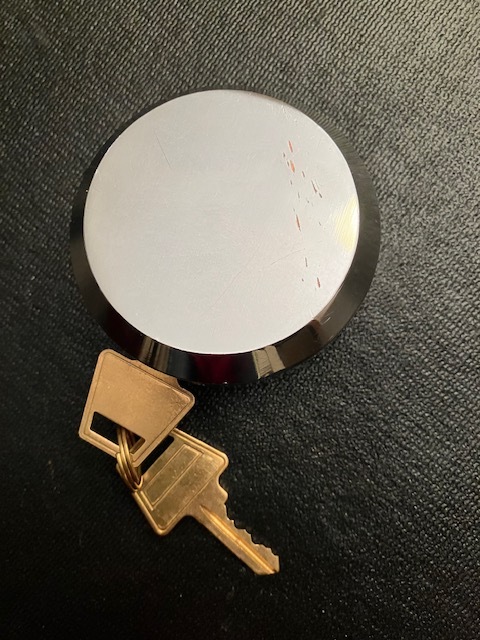
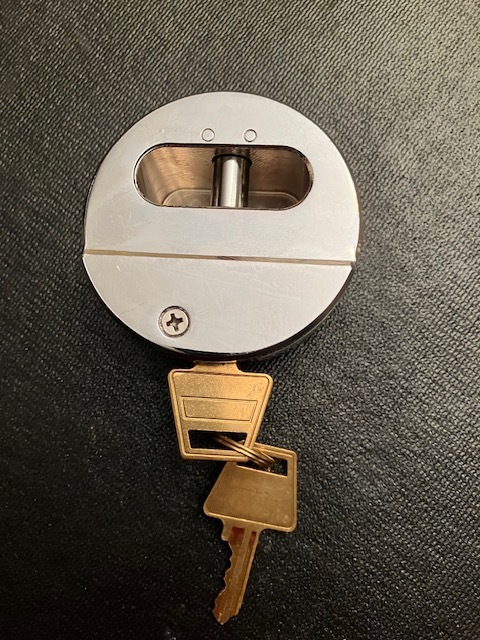
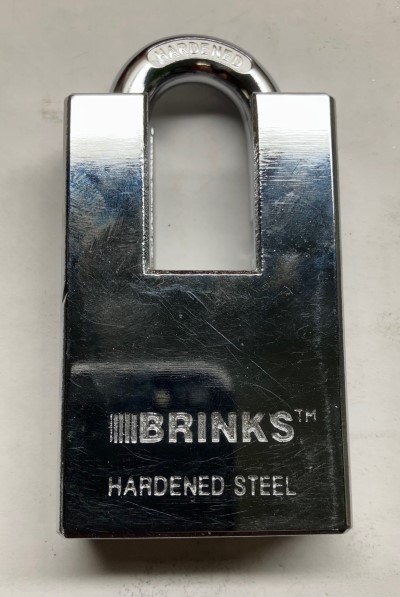
Padlocks are recommended for facilities requiring infrequent access since they are not convenient to use as the lock has to be stored during facility use, and there is no security during use.
Where to Use
- Sheds and detached buildings with infrequent access.
- Shutters, trailers, hitches, toolboxes, and other portable containers with valuable contents.
Benefits
- Wide range of costs depending on robustness and lock mechanism sophistication.
- Portable for multiple uses.
- Minimal installation costs.
- Easily replaced.
- Combination padlocks do not require physical key management and combinations can be changed.
Drawbacks
- The door is not locked when the facility is in use.
- Exterior lock vulnerable to physical attacks.
- Lock storage during use.
- No quick exit when the facility is locked.
Which Lock do I Select as a Door Lock?
Selecting a door lock should be based on your experience with door locks as well as new information you may have acquired from this article.
Have you been satisfied with door locks you have used? If so, your choice may be to stay with the type you have used unless you have new requirements or newly acquired information convinces you that there is a better choice.
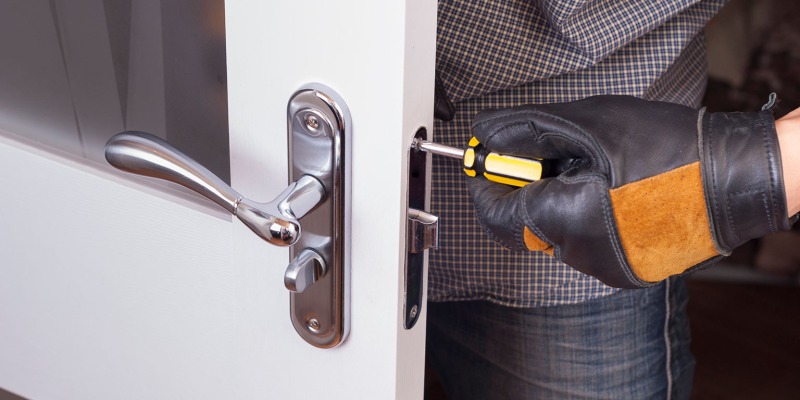
However, have you had issues with door locks that could be addressed with the selection of another lock type? Have your circumstances changed so that your past experience no longer applies? If so, these factors should inform your revised lock requirements.
Remember the main selection factors are security, access, and frequency of use.
There are several questions to ask yourself:
Is the Lock for Internal or External Use?
External use must be more secure due to access by unknown parties. Therefore locks with internal mechanisms like mortise deadbolt, mortise, or cam locks should be considered.
Internal locks can be less secure so knob locks are a good choice. For either application, smart or keypad locks are a good choice if key management and temporary access is desired.
Padlocks can be a good choice for external locations not requiring frequent access and, even though the locking mechanism is exposed, can be fairly secure if shrouded shackle or puck type padlocks are used.
What Level of Security Do You Need?
Knob locks and exposed padlocks are generally low security but are good choices for such an application. Mortise and deadbolt locks can be high security if robustly constructed. Smart locks can be high security if the lock mechanism is internal to the door.
How Many People Need Access?
If only a few, keyed locks do not present a key management problem. If not, smart or keypad locks make access assignments and times manageable.
Combination padlocks are keyless and appropriate for seldomly accessed or detached facilities for multiple users.
Is an Emergency Exit Required for a Lock Facility?
Internal thumb-turn deadbolts/cam locks or mortise locks with a night latch can be used. Smart or keypad locks can also accommodate an internal thumb turn if there is concern about remembering lock codes during panic situations.
What if My Requirements Haven’t Changed and I am Only Replacing an Existing Lock?
In this case, your selection may be largely made for you, and you don’t want to spend the time and expense adapting the door to another type of lock. You can select a different type of lock if the door drilling/mortise and jamb strike plates are compatible.
However, you may want to consider updating to a more modern lock if you like using your smartphone to interface with facility functions. For example, knob, deadbolt, and mortise locks can be easily replaced with keypads or smart locks with the same door fitment factors.
A deadbolt can easily be replaced with a keypad or smart deadbolt locks. The same can be said of some knob and mortise locks. Just check the door drilling/mortising requirements of the new lock.
Review the uses, benefits, and drawbacks of the types of locks to determine the best door lock based on your requirements and consideration of these questions.
Other Factors to Consider in Lock Selection:
Select Hardware Available in Your Area
In selecting a door lock, you should consider what types of locks are commonly available in your area.
This will simplify procurement, installation, replacement parts, keying, and other support functions.
The New Lock May Need to Conform to an Existing Key
Adapting a new lock to an existing key can be a problem, particularly if you don’t acquire the same brand of lock with the same keyway. Manufacturers use proprietary keyways, which limits key use to that type.
In a pin-tumbler lock, this problem can sometimes be solved by replacing the lock core with the compatible manufacturer’s core and re-pinning the core to conform to the key in use.
Lock Backset
When replacing existing door locks, check the distance from the center of the lock to the edge of the door (lock backset). There are standard dimensions, but these vary; if you don’t get this right, you will return the lock for the correct one.
Door Handedness
Some door locks have a specific left or right orientation — particularly lever door handles. Installing a right-hand door lock in a left-handed application will result in the lock being installed upside down. For some handles, this may only be an appearance problem but could cause the lock not to function properly.
To determine door handedness, stand relative to the door so that you are on the inside (for interior doors, stand on the side that operates the lock — for example, inside a bedroom or bathroom).
For in-swinging doors, whichever side the door knob is on is its handedness. For out-swinging doors, whichever side the door knob is on, that is its reverse handedness.
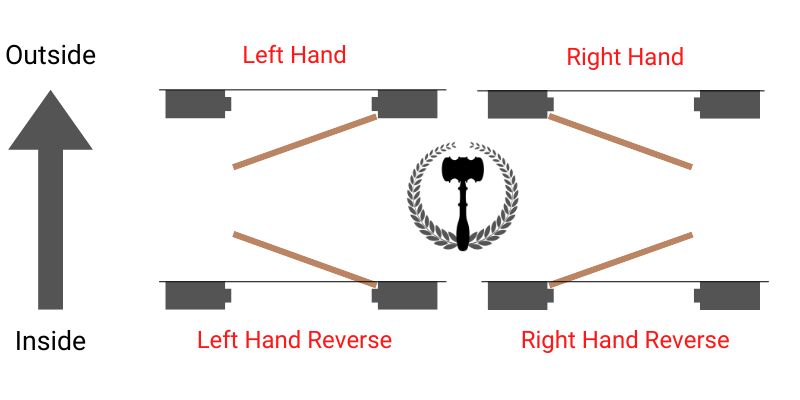
You don’t need to commit these designations to memory. Only be aware that it could matter and be prepared to tell the salesperson/vendor the door configuration, whether in-swinging or out-swinging and which side of the door the knob is on.
Summary
There is a wide variety of door locks available: knob; deadbolt; mortise; cam; keypad; smart; and padlock are the primary ones. These vary in security, access, ease of use, key management, emergency exit, cost, complexity, and availability.
Their use, benefits, and drawbacks are listed to help you understand their use. In order to develop your requirements for lock selection, you should review the use of your required door lock in terms of interior or exterior, security, access, number of people using, emergency exit, and other factors.
These requirements, together with the lock type characteristics listed, are used to select your lock.
Other factors to consider are hardware and support availability, key compatibility, and the sometimes overlooked factors of lock backset and door handedness.
If you liked this article and would like some high-quality door locks, then see our suggestions here.
If this article helped you, please feel free to share it!



